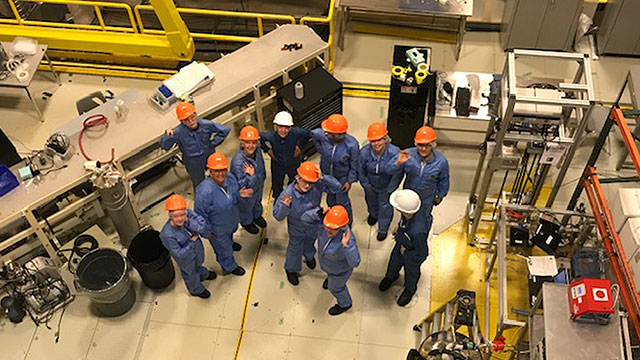
Headlights flash around the elevator, and the rock wall of the elevator shaft streams by as 15 Mi’kmaq students head two kilometres below the surface of the earth.
These students from Nova Scotia are heading to one of the deepest underground laboratories in the world.
The students step out of the elevator and into a tunnel covered in pipes, and wires.
“Being under ground here would be it’s like it’s really, it’s really like mind opening for me cause like I’ve been interested in this for so long,” says student Jayden Leddore.
Watch Part 1 of Angel’s story in Sudbury
You need to go down two kilometres to get away from the earth’s radiation and dust.
The SNOLAB Research Facility is where scientists study neutrinos and dark matter.
“Just to be here and talk to these scientists and talk these things about what dark matter is and why they’re studying it, yeah, it’s a good learning experience,” says Leddore.
The trip is part of a program by Digital Mi’kmaq to encourage Mi’kmaq youth to study science.
Kyle Simon says the tour has opened up new ways to work in science.
“You could get a PhD, get a bachelor’s degree something easy like that or if you want to take a step further you take a professional degree,” says Simon.
Learn more about the research facility: SNOLAB
This is the first Indigenous student group to visit SNOLAB.
“One of our priorities is to make sure we’re inspiring the next generation and we do that through our education and outreach program,” says Samantha Kuula, a spokesperson at SNOLAB
She says western science and Indigenous science both work to understand the natural world – but Indigenous science has been around for 65,000 years.
“And we can only benefit by sharing that knowledge understanding and methods with the western science that we are accustomed to here,” she says.
Simon says the more you learn, the more you can change the world.
“To keep on going with science because with science you can do so much for the world, and we can save, we can save the planet,” he says.
Jeddore says she’s prepared to work hard so she can have a career in science.
“It really takes a lot of dedication, science, science is a really hard subject it takes a lot of math and biology and physics and all that a lot of numbers,” says Jeddore.’
Back on the surface, the students trade in their hardhats for hiking boots.
Measuring 62 km long, 30 km wide, and 15 km deep, they hike the world’s largest known crater.
Where they’re walking is two billion years of history.
Watch Part 2 of Angel’s story in Sudbury
And of course, a learning opportunity.
“I want to experience more of my outcomes in my science fields along in that I want to learn more about nature,” says student Levina Marshall.
“I want to know more about of the underground mines and I want to know a lot more.”
Marshall says more girls needs to be involved in science.
“I never thought I would do but more, it opens my eyes more to more science programs that I would like to do in my present future,” she says.
Dre Toney says he wants to be a role model for the youth in his community.
“I think we need a lot more indigenous to search and discover around the world so we can teach the next generation,” he says.
“I love being here and I hope everyone else does as well… I’m learning a lot and I’m going to learn a lot.”
Laurentian University Professor David Pearson says the crater has many science stories.
“They can read out of the rocks that are under their feet here,” Pearson says chipping away at a rock. “All of these tiny particles and specimens they’ve been picking up were part of what fell back into the Sudbury crater nearly two billion years ago.”
Pearson says he hopes the students are inspired to a career in science.
“I hope that in ten years’ time, when somebody sends me an email about where these students are now that some of them indeed are scientists,” he says.










